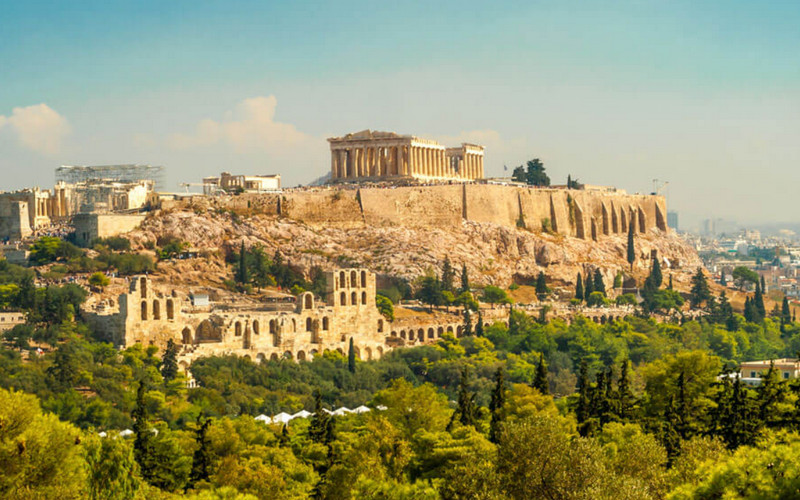The Acropolis and the Divine Contest

The Acropolis is also a significant historical site that has played an important role in Greek history and culture. Exploring the Acropolis and learning about the contest between Athena and Poseidon is a great way to gain a deeper understanding of the cultural and religious beliefs of ancient Athenians. I hope anyone who takes this tour enjoys their experience and gains a newfound appreciation for the mythology and history of Athens.
The Philoppapos Hill and the Spider
Arachne (Greek for “spider”) was a beautiful woman known for her weaving abilities. She boasted that she could weave better than the goddess Athena, the patron saint of textiles, until one day the goddess challenged her to a textile competition that changed her life forever. Climb the beautiful Filopappos Hill (also known as the Hill of Nymphs and Muses) and take part in a weaving competition to change the outcome! Learn about beautiful nymphs and spirits of nature.
God Of Wind
The world’s first weather station is located in Athens’ Roman Agora. The hologion of Andronikos Cyrestes (also known as the “Wind Tower”) served as a sundial, wind vane, water clock, and compass. Walk around the tower and see how each wind god is represented, with Zephyrus, the young wind from the west who tried to seduce the nymphs, and the old, wise, and fearless wind from the north. Meet a certain Boreas!
The Sanctuary of Pan
Pan, the goat-like wild god, is where the word “panic” comes from. The jolly god is known to hunt down beautiful nymphs, and his love book is full of interesting stories. His sanctuary in Athens is just below the Hill of the Nymphs, very close to his beloved consort. Allowing you to sneak into the private lives of Pan and other gods, the Mythology Tour takes you to Athens’ top sights while exploring the love lives of ancient gods and humans!
The National Gardens and the Nature Spirits
The former royal gardens of Queen Amalia and the National Gardens are located right next to Syntagma Square and feature thousands of trees, plants, and many ancient ruins. Each unique tree has a story from Greek mythology, and each path leads to new adventures. Walk through the Forest of Transfiguration with nymphs, mortals and their tragic mistakes, giants, and gods!
God of War
It all started when the gods decided to bring Ares, the god of war, to justice for his war crimes. The rock was named after Ares and became the Athenian Criminal Court. Hear stories of criminals whose fate was decided on the spot while enjoying breathtaking views of Athens from Areopagus Hill! Socrates, the great philosopher of ancient Greece, was tried on the same rock and found guilty of atheism and corruption of the youth of Athens.
The Temple of Hephaestus
It is the best-preserved ancient temple in Greece. The temple was designed by the architect Ictinus, who was also the co-architect of the Parthenon alongside Kallikrates. It was dedicated to Hephaestus, the god of fire and the forge, who shared a very poignant history with the goddess Athena. His sexual advance to the goddess of wisdom was responsible for the birth of Erichthonius, the legendary early ruler of Athens, to whom the Erechtheion, the most sacred building of the Acropolis, was dedicated.
Eleusis and the Gate to the Underworld
There are many gates to enter the kingdom of Hades, but there is one that is very close to Athens. Eleusis is just a 30-minute drive from Athens and is home to the Eleusinian Mysteries, the most sacred ritual of ancient Greece. Enter sacred spaces and walk where, according to Greek mythology, the goddess Demeter walked in search of her daughter Persephone, and learn about the mythical origins of Mystery, an ancient religion that has kept its secrets for over 1500 years.
The Temple of Olympian Zeus and the Titanomachy
The Temple of Olympian Zeus is a former colossal temple in the center of Athens behind Hadrian’s Arch. Today only 16 of his 104 colossal pillars remain, but enough to create an impressive spectacle. The temple took about 638 years to complete! The Greeks believed that building such a huge temple could be viewed as “arrogant” by the gods, so the project was discontinued. It was finally completed during the reign of the Roman emperor Hadrian.
Cape Sounion
A short drive from Athens, enter the kingdom of Poseidon, the lord of the seas in Greek mythology, through the so-called ‘Athenian Riviera’. Walk to the cliff edge next to the magnificent Temple of Poseidon. There the old king waits patiently, staring at the infinite blue below him, waiting for his son to return from his quest. Hear about Theseus, the founding father of Athens, and his adventures in Crete and the mythical palace of King Minos.